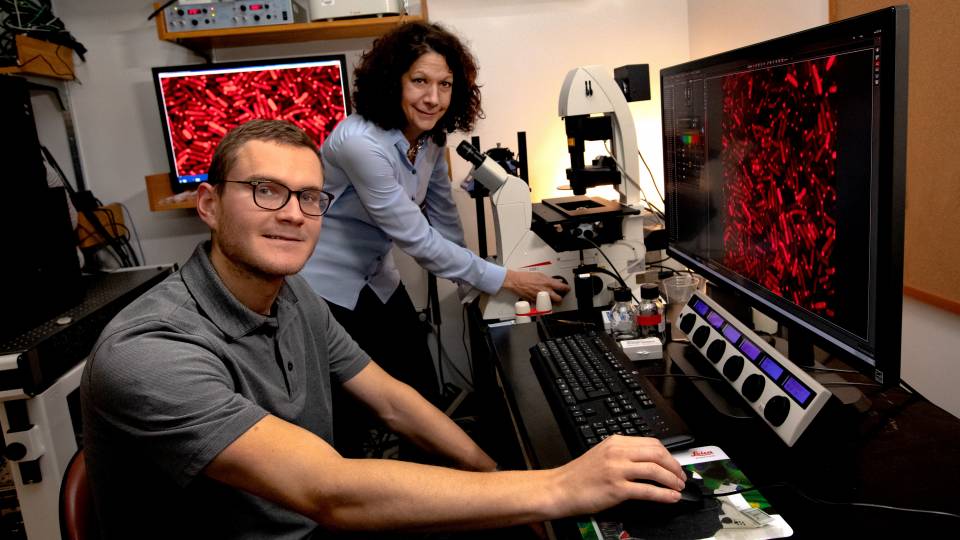Finding could aid in development of antibacterial drugs
Princeton scientists have identified a molecule that bacteria use to communicate with each other, a discovery that may eventually lead to drugs capable of disabling the germs without triggering antibiotic resistance.
The molecule is a key signal in an activity called quorum sensing -- the ability of certain bacteria to perform functions only when they are part of a sufficiently dense population.
The discovery, published in the Jan. 31 issue of Nature, culminates years of searching for the signaling factor. It also is of interest to scientists because the molecule turned out to contain the element boron, which has almost no other known use in biology.
"It is a detective story -- one with a surprise ending," said Princeton University biologist Fred Hughson, who led a team of researchers through a series of painstaking and unorthodox approaches to identify the molecule one atom at a time.
The search began in 1993 when Princeton biologist Bonnie Bassler found genes that allow some ocean-dwelling bacteria to emit a blue glow. The bacteria glow only when there are enough of them for the light to be visible. Bassler later found that many kinds of bacteria employ the same signaling system and respond to each other's signals, a finding that sparked widespread interest in the subject.
Scientists have now shown that at least 50 kinds of bacteria produce this signaling molecule, called autoinducer-2 or AI2, including E. coli and others responsible for human disease. "They are biding their time until they grow up to some critical population density at which they turn on their virulence factors," said Hughson. This trick may help the bacteria evade detection by the immune system during the earliest stages of infection, he said.
Although they knew the bacterial genes and proteins responsible for making and receiving the signal, Bassler and others could not identify the AI2 molecule itself. "They tried every trick in the book, basically everything you could think of," said Hughson.
Bassler turned to Hughson, whose specialty is finding the three-dimensional structure of large, complicated protein molecules. Their plan was to study the AI2 receptor, a protein called LuxP, while the AI2 molecule was anchored to it.
The approach was like assembling a large jigsaw puzzle to determine the picture on one missing piece. LuxP is made of thousands of atoms, but AI2 has only 16. Hughson's postdoctoral research associate Xin Chen used a technique called X-ray crystallography to map out each LuxP atom and found a small pocket that contained a cluster of atoms they knew must be AI2. He then used the nearby LuxP atoms and other clues to deduce the identity of each AI2 atom.
One atom of the 16 proved particularly difficult to pin down. The biologists assumed it was carbon -- the backbone of nearly all biological molecules -- but chemists who were consulted said a molecule with carbon in that spot would be unstable.
Hughson was trying to write a scientific paper about AI2 on a Saturday morning in August when he became convinced that the troublesome atom must be boron, which is next to carbon on the periodic table of the elements.
Later the same day Stephan Schauder, a postdoctoral researcher in Bassler's laboratory, tried adding boron to a dish of the luminescent marine bacteria and found that that it caused them to glow much more readily than they did in their normal culture. Final proof came from another technique called nuclear magnetic resonance spectroscopy -- a variation of medical MRI scanning -- which revealed a clear signature of boron.
"We were very excited when we found that," said Hughson. "It's just not an atom that anyone ever thinks about as having anything to do with biology."
In the end, the presence of boron allowed a more complete analysis than would have been possible had the atom been carbon, said Chen, who is now a researcher at the pharmaceutical company Pfizer Inc. "Initially we did not think we would have such strong evidence to prove our results," he said. "The accidental discovery of boron cracked the problem and made the proof more convincing."
With the exact composition of AI2 in hand, Hughson said biologists could now conduct many more detailed studies on quorum sensing. Pharmaceutical companies are likely to attempt to develop "analogs" of AI2 -- nearly identical molecules that bind to the LuxP receptor, but that do not trigger the quorum-sensing response and would prevent bacteria from releasing harmful toxins, Hughson said. Such a drug would not be a typical antibiotic in that it would probably not kill the bacteria, but would disrupt its activity. For that reason, bacteria may be less likely to develop resistance to the drug as they have to many antibiotics.
Princeton University and the University of Calgary jointly hold a patent on Bassler's earlier work and have licensed it to a company, Quorex Pharmaceuticals. Bassler serves as a scientific adviser to the company.
"It's an interesting idea and people are really excited about it," said Stephen Winans, a bacteria specialist at Cornell University. Winans noted that although many bacteria produce AI2, it is not clear that they all use it for quorum sensing. The next steps will be to pinpoint exactly which bacteria use it and how they use it, he said.
In the meantime, said Winans, the identification of AI2 is a significant advance. "Bonnie took this terrific turn and looked at the problem in a totally different direction," he said. "I think it was a fantastic way to answer the question."
Contact: Marilyn Marks (609) 258-3601




